Support strong Canadian climate journalism for 2025
This is the second article in a three-part series on "Electrify Everything" in Canada.
In the first instalment, I looked at the climate urgency to "electrify everything" and how Canada's done so far.
Summary: Fossil fuel use in Canada has been surging faster than overall energy use. That's increased Canada's dependency on fossil fuel burning from 70 per cent in 2005 to 74 per cent now. In contrast, Canadian electricity use has fallen to just 20 per cent of our energy use. Instead of "electrifying everything" — as required to stop the climate crisis — we're busy de-electrifying.
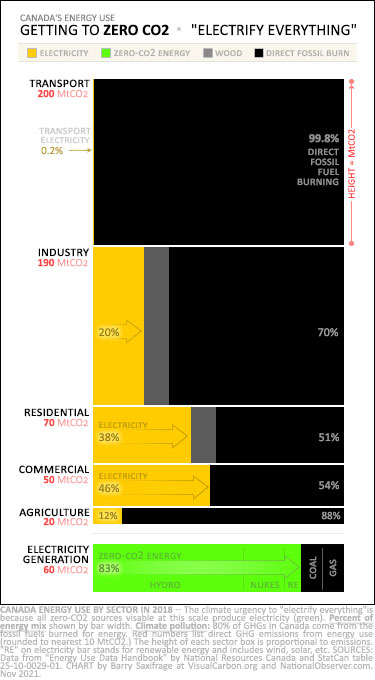
That's according to data in National Resource Canada's Energy Use Data Handbook, which covers the years 2000 to 2018.
I used that same data to create this "Electrify Everything" overview chart. It shows the energy mix and emissions for each sector in Canada's economy.
In my first article, I briefly walked through this chart sector by sector, and gave a summary of our electricity generation.
In this second article, I'm going to take a closer look at the top sector on the chart — transportation.
Transportation is at the top because it emits the most climate pollution — around 200 million tonnes of CO2 per year (MtCO2). Climate pollution is the reason we need to make this energy transition. And the chart emphasizes this by setting the height of each sector's box to match its emissions from energy use.
Not only is the transport sector our biggest emitter, it is also Canada's least electrified — at a fraction of one per cent.
Digging deeper
This government data divides transport into three sub-sectors — moving people, moving freight, and off-road vehicles (logging machinery, tractors, harvesters, and the excavators used in mining).
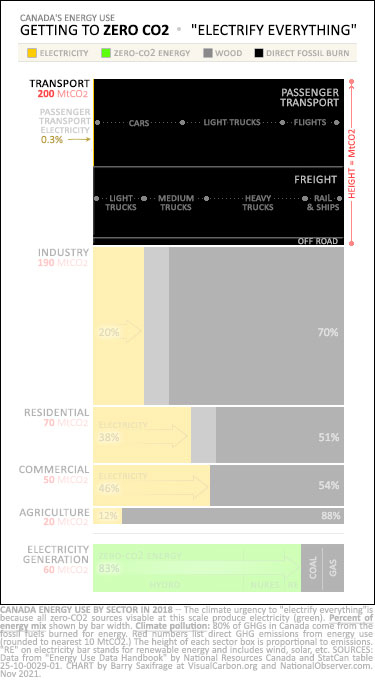
Freight and off-road vehicles are responsible for a little bit less than half of our transportation energy and emissions. As the chart shows, freight trucks of various sizes dominate. Electrification is so insignificant, the handbook doesn't even have an electricity category for them.
Passenger transport consumes even more energy and emits even more climate pollution. Electricity use is trivial at less than one per cent. The orange bar for it on the chart is barely visible.
For all the media and political chatter about electric vehicles (EVs), as we will see below, Canadians aren't buying many. Instead, more than 97 per cent of the new passenger vehicles Canadians bought last year were fossil burners.
Transportation energy trends
As my "Electrify Everything" chart makes painfully clear, more than 99 per cent of Canada's transport is still dependent on burning climate-destabilizing fossil fuels. And that's not even the most disheartening part. Even worse for our hopes for a safe future, fossil burning keeps surging out of control all across the transportation sector.
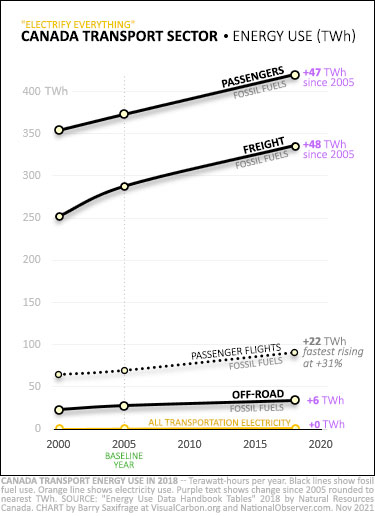
As the purple text on my chart shows, fossil burning for passengers, freight and off-road rose by a combined 100 TWh — just since 2005. That's Canada's baseline year for our Paris Agreement climate targets.
In contrast, electricity rose only 0.24 TWh. That's the orange line lying flat on the floor at the bottom.
The climate math for our transportation is brutal: Canadians have cranked up fossil burning 420 times more than electricity since 2005.
We're stomping the fossil pedal hundreds of times harder than the clean energy pedal. Our kids are strapped in the back seat and the adults are accelerating everyone right off the climate cliff.
Nearly all the fossil burned for transportation is some form of oil — gasoline, diesel, jet fuel and ship fuel. I honestly have no idea why the oil-boosters in Alberta are so grumpy these days. Fossil oil isn't just winning big in Canada, it's crushing our climate-safe energy hundreds of times over. Even the phrase "left in the dust" would be a huge exaggeration because Canadians' fossil oil burning is so far ahead and pulling away so much faster that its dust will have settled centuries before our climate-safe electricity limps along.
We are digging an absolute massive climate hole for ourselves.
How government policy pumps up fossil burning
The lion's share of all this fossil fuel burning comes from a single source — the gasoline and diesel sold at the pump.
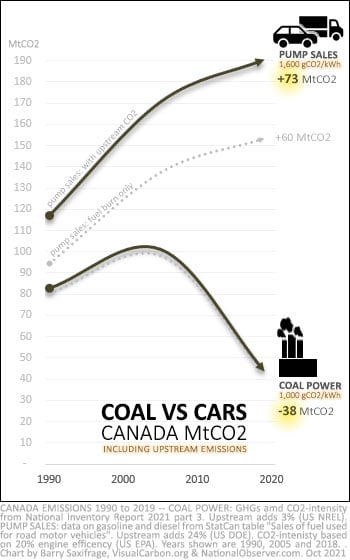
As my next chart shows, the climate pollution caused by Canadian pump sales surged 73 MtCO2 since 1990.
That more than wiped out all the progress Canadians made shutting down coal power.
Why are pump sales skyrocketing in Canada?
A primary reason is that Canadian policy keeps our gasoline taxes so far below the average paid by our peers in other OECD and G7 nations. For example, Canadians pay $400 less to dump each tonne of CO2 out our tailpipes than the British, Germans, French or Norwegians.
Canada's government likes to sell itself as a carbon pricing leader. But when it comes to our biggest and most out-of-control emissions source, the reality is the exact opposite.
Keeping it so much cheaper to climate pollute in Canada creates incentives to climate pollute more. Which is exactly what is happening.
It adds up. The average car in Canada emits 66 tonnes of CO2 out its tailpipe over its lifespan. At $400 less per tonne, Canadians end up paying $26,000 less to climate pollute per vehicle than our peers in Britain, Germany, Norway, or France.
With government policy like that, it should come as no surprise when the International Energy Agency reports that Canadians buy the world's most climate-polluting new cars and trucks.
And by making it dramatically cheaper to climate pollute with gasoline vehicles, it also dramatically reduces the incentive for Canadians to choose a vehicle powered by electricity instead.
Slow-walking electrification
My next chart shows the percentage of new passenger vehicles that use electricity in Canada versus many of our peer nations. We're the ones way down at the bottom.
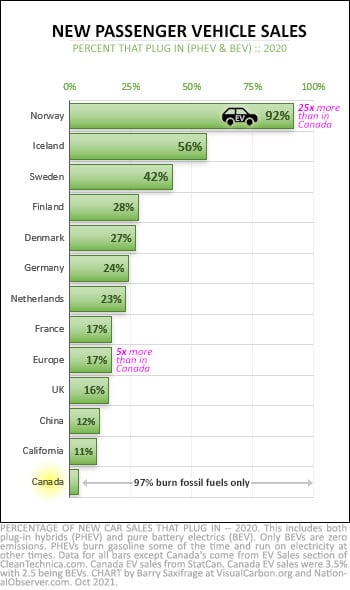
Only three per cent of the new passenger vehicles Canadians bought last year can be powered by our super-clean electricity.
Instead, we continue to pack our roads and driveways almost exclusively with new fossil burners. They will still be burning up a storm and locking in Canadian climate failure far beyond 2030.
It doesn't have to be this way.
Canada could have matched what our northern oil-producing peer Norway did.
Years ago, Norway enacted a suite of policies to favour climate-safer EVs. Today, Norwegians choose EVs for more than 90 per cent of their new passenger vehicle sales. Their fleet is becoming so electrified, that pump sales have declined in Norway for several years in a row.
We could do that now.
Canada could also have matched what the British did in the 1990s to rein in transport emissions. They raised their gasoline taxes the equivalent of $290 per tCO2 over just eight years.
We could do that now.
We have lots of examples of effective, proven climate policies that we could adopt. We just aren't acting.
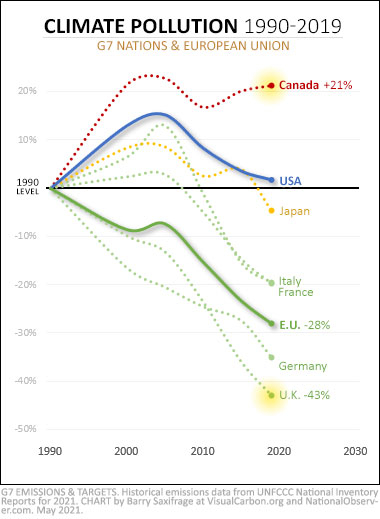
Canada first promised to reduce our oversized climate pollution way back in 1988. As my final chart sadly shows, we haven't. Instead, we have the worst climate record among our G7 peers. By far.
Is this really who we want to be?
If not, then we need to start cutting our fossil fuel burning and "electrify everything" instead. And that's especially true for our most-polluting and least-electrified sector: transportation.
What would that look like?
First and foremost, it means not buying any more fossil-burning vehicles. Every time a new fossil burner rolls off the lot, all its future climate pollution gets locked in. And the opportunity to switch over to Canadian-made, climate-safer electricity is lost for another decade or two — until that vehicle gets scrapped.
And a second big climate step many Canadians can take with their transportation dollars is to stop burning fossil jet fuel. That's our second-biggest cause of transportation emissions and the fastest-growing since 2005. So, when you fly, just make sure you opt for a zero-emitting flight. Pick one that is powered by electricity or green hydrogen.
The aviation industry has been talking about its commitment to provide clean, climate-safe flights for decades. So, surely there are many great climate-safe flight options to choose from by now. And if for some reason you can't find one, then you can always do what I and a growing number of climate concerned folks are doing — stay grounded until Big Air offers more than a sparkly coat of greenwash over its soaring climate damages.
The bottom line is this government data has made painfully clear that our fossil fuel burning continues to rise dangerously in Canada. And that is especially true when it comes to moving ourselves and our stuff around. If we want a fighting chance at a safe and sane future, we need to start acting like it’s a crisis, stop our burning, and get to work electrifying everything we do.
--------------------
Next up: This was Part 2 of a three-part series on "Electrify Everything" in Canada. The final article will look at one of Canada's most electrified sectors — residential buildings.







Comments
I drive a hybrid which is really the only option in my small community because as far as I know there are no charging stations in my community and the town offers very limited and mostly poor quality shopping so most people drive 60 is one way to shop. However my opinion on climate change is yes let’s do all that we can but I have a sinking feeling that we have gone past the tipping point. While nuclear energy sounds great the problem of what to do with the waste and the possibility of disaster are both very large.
If you look at nuclear energy for more than a couple of minutes it doesn't sound great at all. It's ridiculously expensive and incredibly slow to build. If governments all in lockstep started spending gigabucks on nuclear power tomorrow, there wouldn't be any new nuclear plants until somewhere in the 2030s, a bit late to be very much use.
For that matter, uranium is not a renewable resource. Sure, they say there's enough to last a couple hundred years . . . at current usage levels. Multiply it by 10 or more to produce all the electricity fossil fuels make now plus all that vehicles will need and so forth, suddenly you have a 20 year supply. And the last few years of that you're moving to lower and lower quality ores.
Contrariwise, it's likely that the supply of sunlight and wind will last quite a while.
Two factors that people keep missing:
First, all those fossil-fuelled machines could be powered by carbon-negative synthetic fuel. Making them would re-use atmospheric carbon, and be taxed to sequester some as well.
Second, our cars are absurd masses of image-enhancers. There is no good reason for a land vehicle to weigh more than it carries. When the payload is just a small fraction of the weight, it is moving the car that we mostly pay for.
That first thing sounds incredibly inefficient compared to just using batteries. I'm unconvinced by the effectiveness of the basic process of grabbing CO2 out of the air, let alone then turning it into fuel. Laws of thermodynamics and conservation of energy make me think it's not possible for the lunch there to be anything but real expensive.
The second point is quite true . . . but we're not going to change it without dumping capitalism. Not that I'm against dumping capitalism, I just want to note that it's not a simple fix.
Extremely expensive high-tech mechanical solutions that pull carbon directly from the atmosphere are nowhere near as cost effective and efficient as regenerative agricultural practices. Conservation tillage and cover crops that pull carbon from the air and sequester it in the soil (ditto nitrogen) can remove hundreds of millions of tonnes of carbon every year if practiced on a large scale. Moreover, farmers have better yields from healthy, nutrient-rich soil and see their machinery maintenance costs reduced in a major way.
What's not to like about that?
There's at least one good reason I can think of: travelling anywhere on a freeway means sharing the roadway with huge transport trucks. Even a motorbike, weighing considerably more than its passenger, can get sucked right under the darned things.
We drive a 2021 Toyota Prius hybrid (good gas mileage, not junking another car, reducing kilometres driven generally etc.). We have been holding off on buying an EV with concern over the rare metals mining concerns around the batteries. This is amplified at the moment with Ontario's plan to destroy lands in the "Ring of Fire" area to mine metals used in EVs (and mines in Africa and other developing countries with impacts on those citizens and communities). Has someone done a full-cost accounting analysis that would put our minds at ease on the metal mining side of things, encouraging us further to purchase an EV (including I suppose any EVs that are addressing the metals issue head-on)?
Sorry that should have read "we drive a 2012 Prius".
Similar reasons are holding us back on battery electric vehicle (BEV). There are no disposal regulations for end of life batteries. Recycling processes use chemicals that risk our pristine waterbodies. In a decade or so, we will be facing a problem worse than plastics.
Resale value will also be limited because of limited use cases (condo residents cannot charge them reliably).
Have you looked at fuel cell electric vehicles (FCEVs)? Unfortunately, the closest hydrogen fuelling station (HFS) for us is 30 minutes away. According BC ZEV infrastructure roadmap, our neighbourhood will not get an HFS until 2030. Disappointing.
"And a second big climate step many Canadians can take with their transportation dollars is to stop burning fossil jet fuel. That's our second-biggest cause of transportation emissions and the fastest-growing since 2005. So, when you fly, just make sure you opt for a zero-emitting flight. Pick one that is powered by electricity or green hydrogen.
"The aviation industry has been talking about its commitment to provide clean, climate-safe flights for decades. So, surely there are many great climate-safe flight options to choose from by now. And if for some reason you can't find one, then you can always do what I and a growing number of climate concerned folks are doing — stay grounded until Big Air offers more than a sparkly coat of greenwash over its soaring climate damages."
Please talk to your employer / Observer contract managers about that, Barry, if you haven't already done that. Perhaps they could provide a rationale that justifies injecting 35-70 tonnes of CO2 (and other polluting gases) directly into the upper atmosphere just to schlepp a short dozen writers and editors across the world as spectators to the COP26 proceedings in a COVID hotspot, an event that was already being widely reported on by hundreds of other journos.
I don't recall reading your name on the list of high flying climate fighters; perhaps there was an internal discussion where you stood up for your well earned principles and refused to go, or you criticized the managing editors for their climate hypocrisy? Something tells me I won't need to hold my subscriber's breath waiting for their reasoning.
Thanks for your comments on this, Alex. I deliberated long and hard about my decision to take the team to COP. I can't say that this wasn't a decision without an upside and a downside and you very accurately point out the downside.
But I still believe it was the right decision. Our job as journalists is to be where stories are breaking and to absorb information so that we can provide it to our readers. Being at COP was an investment in the collective expertise of our team, and meeting people in person expanded what we can do as journalists, what we know about and who our sources are now. I hope that over the next year, the upside will be reflected on a daily basis in what you read on these pages.
Thank you again for writing me about this, for bringing it up in comments and, above all else, for subscribing.
Thank you for your reasoned response, Linda. Though I respectfully disagree on the need to send staff overseas in person to important events when a reasonable alternative would be to draw up temporary contracts with several local UK journalists to report exclusively to the Observer, with a tiny fraction of the carbon footprint. This is a common practice with many media organizations that are not large enough to have permanent EU and Asia staff on board, and especially with myriad 21st Century communications technology. Of course, the emissions issue would have been moot if the conference took place in Vancouver. However, you'd still would have had COVID to contend with.
Your reply is greatly appreciated.
It may have been educational for NO people. But I read nothing, actually nothing, in NO's reports that I'd not read earlier elsewhere. So I do question. And we all know full well that there *are* no zero-emission flights ... and by now also that the chances the "carbon write-down" was also fake.
Maybe we should all have learned from the 2008 crash, that if it looks too good to be true, or takes a lot of arithmetic to make sense of it, it should be left alone.
It’s obvious that the retail price and supply levels of both domestic vehicles and fuel are too cheap and plentiful to make a difference in the climate fight. Canada also has a baked in suburban dependency on cars by design.
The angle of this piece places a lot of emphasis on the morality of personal choice and responsibility regarding transportation, but another observation is that consumer availability just isn’t there yet. Some of that is due to the pandemic which has caused severe supply chain disruptions and delays, notably from microchip manufacturers. The largest chip manufacturer in the world is based in Taiwan, and their delays have had worldwide implications not just in the production of EVs but also in electronic equipment in general, such as cell phones, TVs, PCs, laptops, broadcast studio gear, washers and dryers, wind generator parts and so forth.
Those companies that haven’t had a chip shortage are making their own and secured material supplies on their own initiative. China is also hoarding rare earths that are used in electronics. Canada, the US and Mexico are probably in the best position to be relatively independent of Chinese or EU manufacturing and parts shipments, but our EV making capability is in its infancy and is too subject to American auto dominance and trade hegemony. That means a lot more government injections of cash are needed to bring down prices under climate policy.
In other words, it’s complicated.
If a family does the math it will become obvious that EVs have far fewer operating costs than fossil burners. But one also has to drive a lot in current common urban design conditions to make the extra ~$10K sticker price worth it in terms of fuel savings. Those who live in denser, poly-zoned, transit rich neighbourhoods don’t have to drive as much, if at all. In fact, in terms of overall efficacy, inner city property owners subsidize suburbanites to the tune of around $10K a year (public utilities, roads, etc.).
A more accurate measure than tallying the overall emissions of the national vehicle fleet would be vehicle km driven per capita, city vs suburb. When broken down like that, it stands to reason that urbanizing the suburbs with high capacity electrified rail and the upzoning of suburban malls from los value asphalt to genuine self-contained walkable and transit connected villages and towns will not just make for more efficient urbanism, but will lower the demand for driving.
Switching out the fleet of fossil burners for EVs is not a final answer for cities, which still must subsidize all automobiles, notwithstanding the positive impact on emissions of EVs. We are retired and live in a walkable inner city community with 500 shops within an 15-minute walk, including nine food markets. We have a tiny econobox — yes a fossil burner — but drive so little that there is no justification to spend $30K++ converting it to an EV.
Cars of any kind are a very poor investment to begin with; they depreciate in value the moment you drive them off the dealership lot. It is far, far more affordable for individuals and families to support major investments in sustainable urbanism, which naturally elevates transit, walkability and site multiple uses (homes, offices, schools, shops …) while downgrading private vehicles to better resemble what that really are: troublesome objects that take up way too much precious city space and that require major public subsidies just to maintain the massive infrastructure that underpins them.
If the single-family detached home on a large lot is obsolete under 21st Century sustainable urbanism precepts, then so is the almighty car, especially those with a single occupant driving long distances. I tried commuting long distance for two years, and concluded that daily commuting marathons are for migratory birds. I switched jobs to one that was a lot closer to home. Before that my commute was a three-minute walk door-to-desk, and we went car-free for a decade. That was nirvana.
As we speak, two new natural gas refueling stations in BC are being subsidized with $1.5 million from federal EV Deployment Initiative Program.
https://www.nrcan.gc.ca/energy-efficiency/transportation-alternative-fu…
One station in Abbotsford, another in Kelowna (short ride from Merritt). Considering the devastating flooding events of last month, the cruel irony of these two locations was not lost on me. Disappointing.